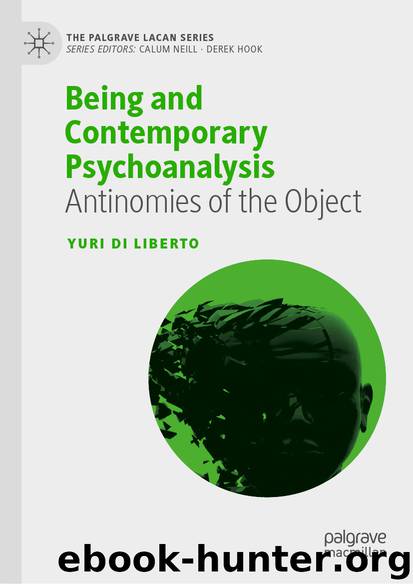Being and Contemporary Psychoanalysis by Yuri Di Liberto

Author:Yuri Di Liberto
Language: eng
Format: epub
ISBN: 9783030184766
Publisher: Springer International Publishing
This passage works to show how the previously outlined account of sublimation does not really correspond to the novelty of psychoanalysis. Lacan’s view is that in language or speech as such lies already sexuality. Language, in all its possible actualizations, is already satisfactory (i.e. sexually satisfactory). A point which, to be fair, illuminates the peculiar Kantianism of psychoanalysis in that here Lacan seems to come close to the philosophical positions of Kantians like John McDowell: in short, to positions defending the idea of an unavoidable conceptual character of cognitive functions, where conceptual is here to be taken as standing for ‘language-based’.
This explicit passage is used to explain that the goal (Ziel) of the drive is satisfaction, but that nonetheless this satisfaction occurs through mentalization.
For example, drive, in the case of the oral drive, goes around its object—the breast—but it is not in the order of the need; it is not a matter of physically filling up one’s mouth. It is the «pleasure of the mouth» (Lacan 2003: 164) itself which gains the status of an autonomous activity. It is not “this mouth” which enjoys but, rather, an enjoyment which is—to use a neologism—a “mouth-ing” (a term which curiously resembles the meaning of “kissing”). Or, to state it in a more sophisticated way, in the oral drive there is in play a mouth-diagram: a particular set of possible operations with particular physico-geometrical constraints and possibilities.
It is thus repetition which paves the way for fantasy; it is the repetition of this putting-into-form (or deformity) of object small a which generates forms from other forms; Lacan uses here the expression of the «repeated reproduction of this enforme» (Lacan 2006b: 394). Enjoyment is, as such, what «remains sideways to what it reaches», that is, to reproduction (Lacan 2011b: 115).
Because of that, the plethora of sublimations includes thinking as another way of missing the target of reproduction. Enjoyment, in the speaking animal, is always misunderstood (ibid.); all these diagrammatizations of objects a portray enjoyment as giving rise to a cornucopia of possible ways of satisfaction which are already, so to speak, slipping out of a possible social acquisition. There’s no room here for Aristotle’s hierarchy of pleasures: a hierarchy between ‘lowest’ and ‘higher’ pleasures or between the noble and the low.
To use Mario Perniola’s reflections, enjoyment (along its objects) is already something slipping out of life (and, a fortiori, of vitalism): it has to do with the inorganic life of pleasure (Perniola 2004: 178–179). Or, more precisely, with the inorganic side of the organic (a theme Freud famously acknowledges through the death drive).
This schema of an object which is not transparently accessible to the subject but that nonetheless exercises a diagrammatic or forming capacity is what Lacan condenses in the formula of an object which is excluded from the subject because of its extreme proximity: the subject, as he puts it, «is in internal exclusion to its object» (Lacan 2002: 865). A schema that can be thought via the notion of extimité, something which is outside the subject because it is placed in its farthest interiority.
Download
This site does not store any files on its server. We only index and link to content provided by other sites. Please contact the content providers to delete copyright contents if any and email us, we'll remove relevant links or contents immediately.
Rewire Your Anxious Brain by Catherine M. Pittman(18589)
Talking to Strangers by Malcolm Gladwell(13290)
The Art of Thinking Clearly by Rolf Dobelli(10321)
Mindhunter: Inside the FBI's Elite Serial Crime Unit by John E. Douglas & Mark Olshaker(9260)
Becoming Supernatural by Dr. Joe Dispenza(8166)
Change Your Questions, Change Your Life by Marilee Adams(7684)
Nudge - Improving Decisions about Health, Wealth, and Happiness by Thaler Sunstein(7655)
The Road Less Traveled by M. Scott Peck(7554)
The Lost Art of Listening by Michael P. Nichols(7453)
Mastermind: How to Think Like Sherlock Holmes by Maria Konnikova(7278)
Enlightenment Now: The Case for Reason, Science, Humanism, and Progress by Steven Pinker(7272)
Win Bigly by Scott Adams(7139)
The Way of Zen by Alan W. Watts(6548)
Daring Greatly by Brene Brown(6473)
Big Magic: Creative Living Beyond Fear by Elizabeth Gilbert(5676)
Grit by Angela Duckworth(5554)
Ego Is the Enemy by Ryan Holiday(5347)
Men In Love by Nancy Friday(5192)
The Laws of Human Nature by Robert Greene(5080)
